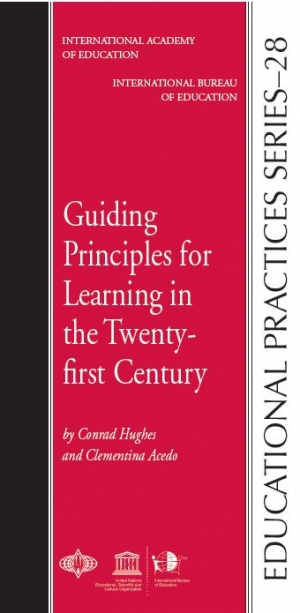Introduction
The purpose of this booklet is to offer guiding principles about learning in the twenty-first century. It is intended for teachers, curriculum designers, school leaders, and others involved in all levels of school education and can be used for any age group, as the principles it contains are general enough to be applied in different contexts. The guide offers a bridge between classroom practice, educational theory, and academic research. It draws on theories developed by researchers and teachers, and on an article of the same title published in Prospects (2014), along with the expertise of educational organizations. Historically, theories of learning, ideas about what we should teach, examples of practice, and suggested models have been developed separately by different organizations. The result has been a lack of unity, with little cumulative knowledge and an absence of cooperation on research.
This guide attempts to address this lack of unity by responding to the question: What is it that students should be learning in the twenty-first century? This challenge takes us back to a fundamental question about the purposes of education: What is education for? The subject areas traditionally taught in school (languages, humanities, natural sciences, mathematics, technology, the arts, religious and physical education) are required by universities and are still relevant. However, there is increasing understanding that new areas of knowledge, competences, and behaviours need to be integrated into curricula if young people are going to function well in an increasingly complex global society. In the future, they may be faced with enormous challenges associated with poverty, overpopulation, and declining bio-capacity.
For example:
• The International Education Advisory Board suggests that twenty-first century learning is and will continue to be linked to information technology;
• The Centre for Curriculum Redesign points to the need for a thorough review of the knowledge, skills, and character necessary for deep and relevant learning;
• The OECD’s Programme for International Student Assessment (PISA) has identified the “need to assess problem-solving abilities as governments around the world seek to equip young people with the skills they need for life and employment” (Schleicher, 2011);
• UNESCO has stated that “concern for peace and sustainable development should be at the centre of our efforts to promote inclusive and equitable societal development” (UNESCO, 2013, p. 1). 7
What is clear is that learning in the twenty-first century involves numerous areas of human development. They go beyond skills and technology to cover all aspects of the social, psychological, and moral development of learners. Educational programmes are often expected to include sustainable development, learning to live together, intercultural understanding, communication skills, and the respectful attitudes towards others needed for genuinely inclusive and peaceful development. Due to this evolution, education may benefit from understanding how to go beyond traditional academic content. This guide offers ten areas for learning that are particularly significant in the present world’s educational climate, in which stability, predictability, and continuity are no longer guaranteed. On the contrary, young people are entering a volatile, unpredictable, complex, and ambiguous world. These ten areas can be divided into:
• Core areas of knowledge (such as information literacy, concepts focus learning, and STEM [science, technology, engineering and mathematics] learning) [sections 2, 5, and 6];
• Competences (such as critical thinking and creativity) [sections 3 and 4];
• Attitudes (associated with academic honesty, health and mindfulness, and service learning) [sections 1, 7 and 8];
• Broad approaches to learning (in areas such as learning support and assessment) [sections 9 and 10].
It is intended to stimulate meaningful reflection on education so that those who read it feel inspired to take up some of the suggestions and adapt them to the realities of their own classrooms. Although the use of these ideas will vary depending on the context, the underlying message will be the same: these guiding principles are essential for quality learning in the twenty-first century.
